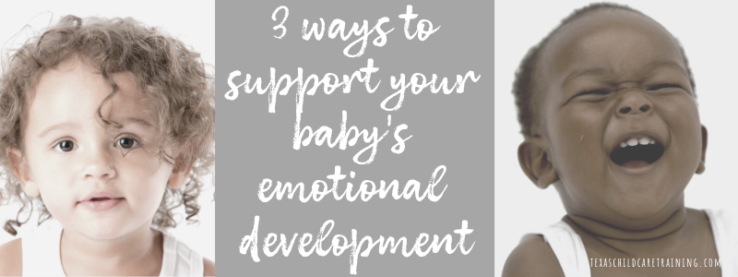Emotional development in the baby room
Babies pick up on our emotions at an amazingly young age. Researchers have found that babies as young as 4 months of age can detect positive and negative emotions in our facial expressions and tone of voice. This ability continues to develop in the first year, and you may see that a baby will show preference to objects and actions that you respond positively to, through your face and voice. This ability to “read” you is very new however, and the process of learning to respond to others’ emotions continues throughout childhood (in fact, many grownups are still working on it!)
As baby gets more mobile and begin to explore the world, you’ll find that he’ll look back for reassurance, taking note of your facial expression, gestures, words and tone of voice. In other words, reading your emotional response to his actions to let him know if it’s safe to continue the adventure.

crawls away to explore.
For example, you’re sitting on the floor in the middle of the classroom with toys strewn around. Baby crawls away from you, towards the section of the room where children are sleeping. Once he’s some distance from you, he looks back at you to see what you think. Is it okay? Can I go all the way over there? Can I crawl under that crib? Are you going to follow me? Your face will tell him… with either a smile and nod that says, “Sure, Ms. Nona is close by, you can go on over” or a facial expression and head nod that say, “No baby, come back in here with me, away from the sleeping children”.
The ability to read your feelings pops up everywhere! Do you really dislike vegetables? They will figure that out. In a study that looked at children’s responses to an adults’ expression of joy, sadness, fear, anger or disgust toward a food item, 18 month old babies were more likely to give the adult food if she expressed sadness, as if she wanted some of it, and if the adult expressed disgust, the baby would push the food away. You can read more here. Moral of that story? If you want a bite of baby’s cookie, give an exaggerated sad face and open your mouth wide. If you want little ones to eat vegetables, express joy and enthusiasm as you model eating them yourself!
This applies to every situation where we express emotions – which is pretty much all day every day.
Being aware of our own emotional state and making adjustments as needed is quite important, because little ones are affected by them. I don’t know about you, but I often have to give myself a strong talking to, to choose joy and gratitude when I’m feeling irritated and put out by others. Which doesn’t mean masking emotions or faking joy, it means doing what’s needed to change my feelings or simply accept the sadness or irritation with the knowledge that it will pass.
Self-care is important – as getting plenty of rest, healthy food, exercise, time with those you love, and pursuing things you enjoy will fill that emotional tank and energize you to care for children well.

When it comes to helping children grow emotionally, we need to be authentic. That means learning to appropriately communicate how we’re feeling (tired, peaceful, upset, joyful, angry, etc.). In doing so, we are giving children the tools to identify, express and manage their own emotions, which can be scary and overwhelming in the first few years of life.
Here are a few things to remember as you think about emotional development…
- Acknowledge their feelings. “You are hungry and you have to wait for the bottle to warm. That’s frustrating and you feel hangry! I understand.” “You want me to hold you but I’m… (fill in the blank). That’s disappointing. I will pick you up in 2 minutes when I’m done.”
- Honestly describe your own feelings, giving words to them and how you plan to cope. “Everybody’s schedule is a little off with the time change, right? I feel tired today too. I’m going to work hard to be happy even though I feel kinda grumpy this morning. Let’s listen to some fun music.”
- Allow children to experience a little frustration – the best way to develop tolerance for frustration is by experiencing and dealing with it in small, manageable amounts. For an 8-month-old, that looks like not coming to rescue when the ball rolls away. Let him figure out where it went and how to get it, even if it rolled under the chair. Be there, at the ready, to help if after a few moments he is unable to get it – but first give the opportunity to solve his own problem.
Encouraging a child means that one or more of the following critical life messages are coming through: I believe in you, I trust you, I know you can handle this, You are listened to, You are cared for, You are very important to me.
Barbara Coloroso
Do this… practice naming emotions as you go through your routines today. See how it helps everyone!
- “You are smiling big this morning, you are rested and full of joy!”
- “You have a sad expression on your face. You’d rather not say goodbye to daddy, I understand. Let’s make it better by singing a goodbye song to him.”
- “I feel… (happy, sad, lonely, impatient, etc.) How do you feel, baby?”
Enjoy those sweet babies!
Until next time,



